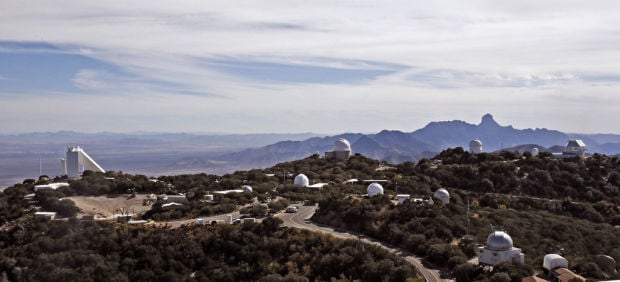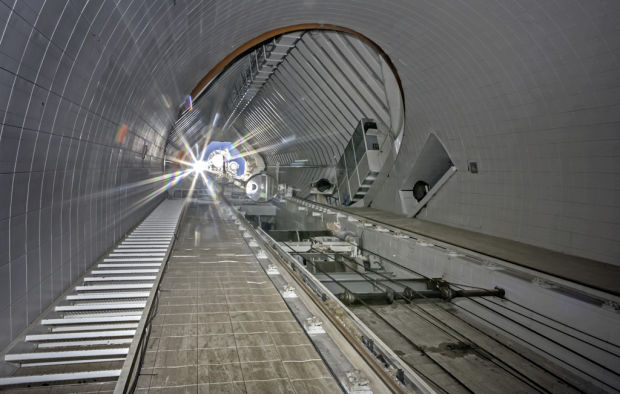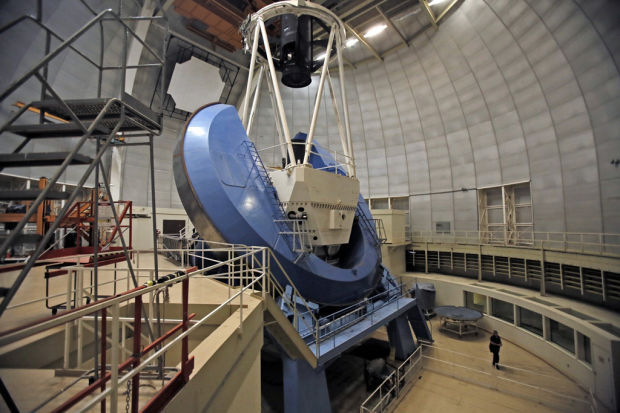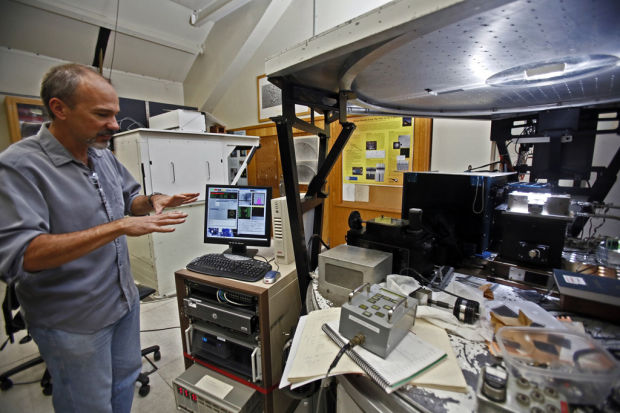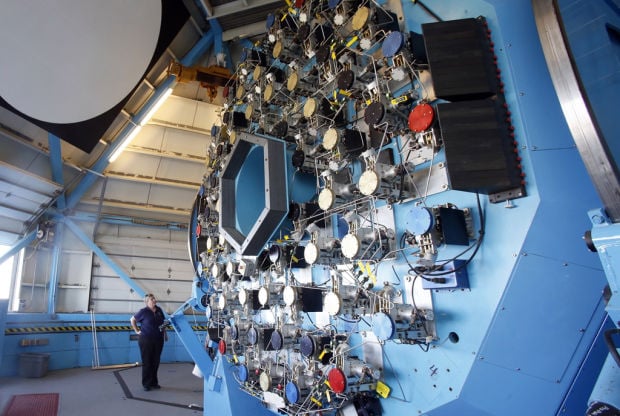Kitt Peak National Observatory could have trouble living up to the “national” part of its name in the coming years.
Its original mission, to host astronomical instruments made available to U.S. researchers on the merits of competitive proposals, could end within three years.
Plenty of science will continue on the mountain. Its biggest tenant, the University of Arizona, has no plans to cut back on its presence, said Buell Jannuzi, director of the UA’s Steward Observatory.
The National Science Foundation, which bankrolls the national solar and optical observatories on the mountain, will be stretched thin in coming years as big new telescopes get built in Hawaii and Chile.
The four instruments it now supports on Kitt Peak — the McMath-Pierce Solar Telescope, the 4-meter Mayall Telescope, the 3.5-meter WIYN Telescope and the 2.1-meter telescope — are all seeking new users or uses and new sources of funding.
The 2.1-meter, the oldest and smallest of the NSF-supported facilities, loses its funding in 2014 and Kitt Peak is soliciting proposals for someone to take it over. The alternative is to mothball the telescope, said Lori Allen, director of Kitt Peak National Observatory.
The WIYN, whose name is formed by its current underwriters — the National Optical Astronomy Observatory and three universities (Wisconsin, Indiana and Yale) — will have to find new partners when the NSF-supported NOAO withdraws from its 40 percent share of the costs as early as 2015.
The 4-meter Mayall Telescope, the largest on the mountain, could host a new instrument, supported mainly by the Department of Energy. Otherwise, it, too, will need a new source of funding.
The McMath-Pierce Solar Telescope, celebrated for its size and stunning design when it was dedicated in 1962, is being eclipsed by the Advanced Technology Solar Telescope, under construction on a mountaintop on the Hawaiian island of Maui.
Its operator, the National Solar Observatory, commonly called NSO, is leaving Tucson for Boulder, Colo., by 2018 or sooner. It will end all operations on Kitt Peak and at its sister facility on Sacramento Peak in New Mexico.
Valentin Pillet, who recently took over as director of NSO, said he knew when he took the job that he would have to preside over the demise of the observatory’s presence in the Southwest. He was lured to the job by the promise of commissioning the new observatory in Hawaii.
“Indeed, this is pretty much what motivated my application — this new and bright future that NSO has,” Pillet said. “It’s something we were all dreaming for quite some time and it’s all green lights right now … .”
Pillet said he also understood “the complexity of the times we are in and the challenge it represents.”
It is, in a sense, easier to leave Tucson, he said. At Sacramento Peak, a remote location where employees live and work on site, “we are not divesting a telescope, we are divesting a community.”
Kitt Peak will lose funding first, he said. NSO will cut its support by 25 percent a year.
“Our commitment is that by the end of 2017, we will no longer be involved,” he said.
McMath still useful
A group of McMath-Pierce users is trying to find money to keep solar astronomy going at Kitt Peak. “I’d call it the million-dollar question, but it’s actually cheaper than that,” said solar astronomer Matt Penn, who would like to continue his long-term study of the energy of sunspot regions into the future.
Penn is joined by other solar scientists, educators and planetary scientists in that effort. McMath-Pierce can be used day and night and is especially useful in observing night-sky objects that are close to the sun, such as the planet Mercury and sun-grazing comets such as Comet Ison.
Ison is the target for three groups of researchers from Japan and the United States who have scheduled night runs on the telescope in the week of Thanksgiving when Ison makes its closest approach to the sun.
Penn said McMath-Pierce can be maintained and run for about $250,000 a year. Potential users have submitted eight grant applications for its continued use, but won’t know of their success for some time.
The cost of dismantling the telescope is also a consideration, said William Smith, president of the Association of Universities for Research in Astronomy, called AURA.
Smith said AURA commissioned a study of the costs of mothballing or dismantling the giant facility, in part to demonstrate to the NSF that it may be more economical to keep the telescope in operation.
Possibly leaving Tucson
The optical telescopes of the National Optical Astronomy Observatory, also headquartered in Tucson with facilities at Kitt Peak and in Hawaii and Chile, are run by the Association of Universities for Research in Astronomy. Its contract is the subject of a competitive proposal that could produce a new manager with headquarters elsewhere.
A “program solicitation” for running NOAO in future years contains this rather ominous line: “NOAO core functions are at present co-located with the NOAO headquarters offices and labs in Tucson, AZ, but that need not be the case in the new award period.”
Jim Ulvestad, director of the NSF Division of Astronomical Sciences, would not comment on initial response to its “program solicitation.” Proposals are not due until January, he said. There are no plans to move NOAO, he said, but the solicitation needed to give flexibility to bidders who already have headquarters elsewhere.
He said the National Science Foundation plans to continue its ownership of telescopes on Kitt Peak. It will support them at a basic level and will entertain “creative partnerships” to keep them operating, he said.
No decisions have been made to close any particular telescope, he said. Any dismantling or mothballing would be a longer process in consultation with the Tohono O’odham Nation, which owns the mountain and allows its use.
Budget shrinking
The National Science Foundation’s budget constraints won’t let it add new infrastructure without divesting some of its telescopes. A Portfolio Review last year recommended the divestment of all of Kitt Peak’s NSF-supported telescopes.
“It’s a difficult choice. If we want to do new things and build new capabilities, you can’t do it all when your budget is going down,” Ulvestad said.
NOAO’s overall operating budget is slashed by 30 percent in a proposed “transformation plan.”
“By August 2014, the 2.1-meter will stop operating as an open-access facility,” said David Silva, the observatory’s director. “By February 1, 2015, we expect we will no longer be partners in the WIYN Observatory.”
Silva said he expects the WIYN to “continue operating and will likely end up being three or more universities without the national observatory.” He hopes the smaller and older 2.1-meter will find a new operator.
The National Science Foundation, in meetings earlier this year with Kitt Peak tenants, agreed to provide baseline funding for Kitt Peak facilities. It has agreed to work with the Department of Energy, which would like to re-engineer the 4-meter Mayall Telescope for use as the Dark Energy Spectroscopic Instrument, or DESI.
There is no contract yet, said Ulvestad, and the new $70 million makeover is not in the Department of Energy’s proposed budget. “NSF will need to need some signal from them that they are able to go forward with DESI,” he said.
The NOAO will continue to provide “open access” to deserving proposals for use of its telescopes, Silva said, but those telescopes will “be predominantly at our facility in Chile.”
NOAO laid off 20 of its Tucson staffers in April 2012 and more layoffs are inevitable, he said.
Under terms of the NSF’s transformation plan, NOAO’s $25.5 million operations and maintenance budget for this year drops to $17.5 million in 2016. The program solicitation says NOAO’s base support for Kitt Peak will be capped at $1 million in the future, with additional money available to keep the Mayall Telescope operating until its transition to the Department of Energy.
Todd Boroson, who served as director and deputy director of NOAO but is no longer affiliated with it, said he understands the need for the National Science Foundation to provide access to bigger, newer telescopes. But he questions its transition plan, which came at the urging of the astronomical community and conclusion of a review of its facilities.
“When NSF carried out the portfolio review, I was pleased that, for the first time, they seemed to have some strategic priorities. Their approach is always to fund the best things that come in, but they’re not strategic at all.”
Now they have a strategy, he said, but no plan for a “strategic evolution.”
“The solution you could imagine is NSF saying, ‘We realize this is a cliff we’re pushing people off of’ and ramp it down by buying time as a community for these telescopes.”
Cuts inevitable
Ulvestad said the NSF could potentially put a “significant amount of money” into Mayall and could provide bridge funding for other telescopes that come up with transition plans.
Allen, Kitt Peak’s director, said the telescopes being de-funded are productive in two measures. They are fully subscribed, with astronomers competing for every dark night available, and they produce refereed, published scientific papers at a clip that rivals the larger telescopes.
Complicating things for the foundation, and for users down the line, is the current state of congressional funding. Battles over the budget, government shutdowns and sequestered funds have made cuts inevitable — and planning impossible.
In the past, threatened NSF cuts have been restored by Congress, said Silva, but “it looks tougher to me than in the past.”
“Nobody knows what their budget is going to be,” he said. This fiscal year was 70 percent over before NOAO knew its final budget figure, he said. “We won’t know about fiscal year 14 for another six months.”


